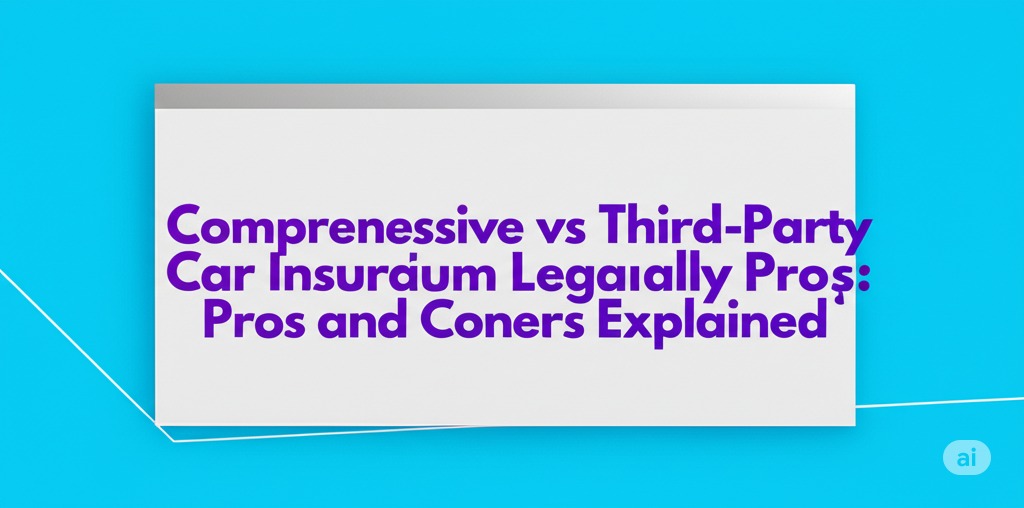Comprehensive vs Third-Party Car Insurance: Pros and Cons Explained
🚘 Introduction
Car insurance isn’t just a legal formality—it’s your financial safety net on the road. But when it comes time to choose a policy, you’ll encounter two main options: Comprehensive and Third-Party car insurance.
So, which one is right for you? The answer depends on your budget, the age of your vehicle, how often you drive, and your personal risk tolerance. This post explains the key differences, pros and cons, and how to choose the best option for your needs in 2025.
🛡️ What Is Third-Party Car Insurance?
Third-party insurance is legally required in most countries, including India and the UK. It covers damage or injury caused to others by your vehicle.
✅ What It Covers:
- Damage to another person’s vehicle
- Injury or death of a third-party person
- Property damage of third parties (limited coverage)
❌ What It Doesn’t Cover:
- Your own vehicle’s damage
- Theft or fire damage to your car
- Personal accident coverage (unless added separately)
📌 Legal Note: Driving without at least third-party insurance is illegal and can lead to fines or license suspension.
🚗 What Is Comprehensive Car Insurance?
Comprehensive insurance offers all-in-one coverage. It includes third-party liability and extends to cover your own vehicle’s damage, theft, fire, natural calamities, and more.
✅ What It Covers:
- Third-party liability
- Damage to your own vehicle
- Theft of your car
- Fire and explosion
- Natural disasters (flood, cyclone, earthquake)
- Vandalism or riots
- Personal accident cover (often included or optional)
❌ What It Doesn’t Cover:
- Regular wear and tear
- Driving under the influence
- Mechanical or electrical failure (unless you opt for add-ons)
⚖️ Comprehensive vs Third-Party: A Quick Comparison
| Feature | Third-Party Insurance | Comprehensive Insurance |
|---|---|---|
| Legally Mandatory | ✅ Yes | ✅ Yes (includes third-party) |
| Own Damage Cover | ❌ No | ✅ Yes |
| Theft Protection | ❌ No | ✅ Yes |
| Fire/Natural Calamities | ❌ No | ✅ Yes |
| Premium Cost | 💰 Low | 💰💰 High |
| Add-Ons Available | ❌ No | ✅ Yes |
| Claim Process | ✅ Simple | ✅ Slightly Detailed |
| Recommended For | Old/low-value cars | New/expensive cars |
💰 Cost Difference: Which Is Cheaper?
- Third-party insurance is significantly cheaper than comprehensive policies.
- In 2025, a third-party plan for a standard hatchback in India can cost around ₹2,000–₹3,000, while a comprehensive policy with add-ons may go up to ₹10,000–₹15,000 or more.
However, lower upfront cost doesn’t always mean better value—especially if you’re not financially prepared for accident-related repairs or theft.
✅ Pros of Third-Party Car Insurance
1. Meets Legal Requirements
You can legally drive your car with just this policy.
2. Low Premiums
Ideal for those on a tight budget.
3. Simple and Fast to Buy
No vehicle inspection or complex documentation needed.
4. Easy Claims (Third-Party Only)
If you’re not at fault, it simplifies third-party claims.
❌ Cons of Third-Party Car Insurance
1. No Coverage for Own Damages
If your car is damaged in an accident, you pay from your pocket.
2. No Theft or Fire Protection
If your vehicle gets stolen or burns, there’s no compensation.
3. No Add-On Flexibility
Can’t include valuable extras like zero-dep or roadside assistance.
4. Limited Customization
It’s a bare-minimum policy without flexibility.
✅ Pros of Comprehensive Car Insurance
1. All-Round Protection
Covers third-party plus own damages, theft, natural disasters, etc.
2. Add-On Options
You can add zero depreciation, engine protection, return-to-invoice, and more.
3. Peace of Mind
Especially useful if you drive daily or in high-traffic areas.
4. Higher Resale Value
Buyers often prefer cars with ongoing comprehensive coverage.
❌ Cons of Comprehensive Car Insurance
1. Higher Premiums
It costs significantly more than third-party policies.
2. Deductibles & Exclusions Apply
You might still pay out of pocket for some damages.
3. Can Be Overkill for Old Cars
Not always cost-effective if the car’s market value is low.
🔍 When Should You Choose Third-Party Insurance?
Third-party insurance is ideal if:
- Your car is more than 8–10 years old
- The vehicle has a very low resale value
- You rarely drive the car
- You want the cheapest legal coverage
💡 Example: An old 2007 hatchback used for local errands may not need full coverage.
🔍 When Should You Choose Comprehensive Insurance?
Comprehensive insurance is a better choice if:
- Your car is less than 7 years old
- You use it daily or for long-distance travel
- You live in an area prone to flooding, theft, or accidents
- Your car is high-value or financed
💡 Example: A new SUV in a city with traffic congestion and high theft risk should be comprehensively insured.
⚠️ Real-Life Claim Scenarios
| Scenario | Covered by Third-Party? | Covered by Comprehensive? |
|---|---|---|
| You hit another car | ✅ Yes | ✅ Yes |
| Tree falls on your car | ❌ No | ✅ Yes |
| Your car is stolen | ❌ No | ✅ Yes |
| You rear-end a truck, car damaged | ❌ No | ✅ Yes |
| Your engine floods in heavy rain | ❌ No | ✅ If add-on taken |
📝 Can You Switch Between Policies?
Yes. During renewal, you can upgrade or downgrade your policy.
Example:
If you had third-party coverage for a year, you can opt for a comprehensive plan when renewing. Some insurers also allow mid-term upgrades, though conditions apply.
🔄 Tip: Always compare prices and check NCB benefits before switching.
📦 Add-Ons Available with Comprehensive Plans (2025)
Here are the most useful add-ons in 2025:
- Zero Depreciation Cover – Get full claim without considering depreciation
- Roadside Assistance – Help if your car breaks down
- Engine Protection – Covers hydrostatic lock and flood damage
- Return to Invoice – Reimbursement based on invoice value in total loss
- Tyre Protection – Covers tyre damage, which regular policies exclude
📌 Final Verdict: Which One Should You Choose?
Here’s a simple rule:
| Car Age | Insurance Type |
|---|---|
| 0–5 years | Comprehensive with essential add-ons |
| 6–10 years | Comprehensive (minimal add-ons) or switch to third-party |
| 10+ years | Third-party only (unless high-value or collector car) |
Your choice should balance coverage, risk level, and budget.
🚦Remember: Cheaper isn’t always better. It’s about value for money and peace of mind.
🔍 Key SEO Keywords to Include
- Comprehensive vs third-party car insurance
- Difference between third-party and full insurance
- Best car insurance type 2025
- Car insurance comparison India
- Which car insurance to choose
✅ Need Help Picking the Right Plan?
Drop a comment below or use our free insurance comparison tool to find the best policy for your needs in 2025. Don’t forget to renew your policy on time and keep your NCB intact!


